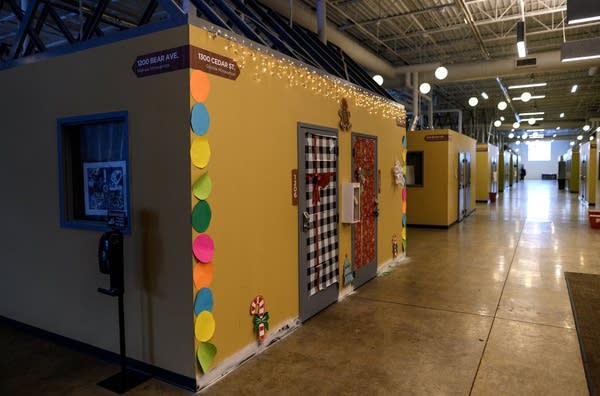Minneapolis considers building second tiny-home village for homeless people
The project would be another location for the city's first-of-its-kind Avivo Village.

Go Deeper.
Create an account or log in to save stories.
Like this?
Thanks for liking this story! We have added it to a list of your favorite stories.
Minneapolis Council Member Jason Chavez recently faced a crowd of 200 concerned residents who he said gave him a simple message, “What we have been doing to combat homelessness is not working.”
The community meeting inside Phillips Community Center was not far from a south Minneapolis encampment that the Minnesota Department of Transportation cleared in late August, leaving an estimated 140 people looking for somewhere else to go.
The overwhelming sentiment among those who attended the meeting in Chavez’s ward was that encampment clearings just lead to more encampments popping up across the city, if not in the same exact places.
A bright spot in the city’s quest to end homelessness has been the innovative Avivo Village, which opened in December 2020. The first-of-its-kind indoor village of 100 tiny homes housed in the North Loop neighborhood provides a low-barrier entry to the shelter as well as a variety of other comprehensive health services.
Turn Up Your Support
MPR News helps you turn down the noise and build shared understanding. Turn up your support for this public resource and keep trusted journalism accessible to all.

On Monday, the 12 council members present at a budget meeting voted to take $1 million from the city’s contingency funds that could lead to additional state money for another such village near the recently cleared encampment. The project would be called Avivo Villages South.
“People deserve safe and dignified housing,” Chavez said. “I’m not saying it is particularly perfect or that it’s meant for every single person that is out on the street, but I will say we are in an emergency and it is a model that will help change a lot of people's lives here in Minneapolis.”
Longtime social worker Linda Eagle Speaker attended the recent South Minneapolis community meeting to address the housing emergency in Minneapolis. Most of the people she sees dealing with homelessness are fellow Native American people.
In fact, the recently cleared encampment that sparked the community meeting is referred to as the “Wall of Forgotten Natives.” According to Wilder Research, Native Americans make up one percent of the state’s adult population but 13 percent of its homeless population.
“There just doesn't tend to be any solutions, particularly for our people,” Eagle Speaker said. “It's just running and hiding, and going on to the next camp and the next camp. We need affordable housing, really intensive treatment programs and more Indigenous-oriented programs.”
Council Member Emily Koski represents the southernmost part of Minneapolis. Koski co-sponsored the effort to set aside the funding for a second Avivo Village location.
“Our emergency rooms have become extensions of our shelter system,” Koski said. “We are in crisis and urgent action is necessary.”
Koski said Avivo Village has reversed 171 overdoses since it opened and has helped 150 people move to permanent housing out of 412 individuals served.
The existing Avivo Village is in Council Member Michael Rainville’s ward near downtown Minneapolis. Rainville applauded the wraparound services offered to the residents entering Avivo Village.
“I’m very impressed with what Avivo Village does in helping people get off drugs because that is a big part of our housing crisis,” Rainville said.

Council Member Lisa Goodman, who serves the western edge of Minneapolis and parts of downtown, supported the additional $1 million in support of Avivo Village but pointed out many other organizations working to end homelessness have successful approaches that also deserved to be considered for an investment.
Council members indicated there was support from Mayor Jacob Frey’s office for a second Avivo Village, but the effort will take a combination of city, county, state and federal partners. For example, Goodman said it is up to the county to fund Avivo’s operation past 2025.
“It’s not solving a problem, it’s challenging others to work with us, the state and the county, in order to solve a problem,” Goodman said. “We are saying to the state, ‘put your money where your mouth is, and if you do, we will.’”
The Minneapolis City Council is also working on approving next year’s city budget in December.
Dear reader,
Political debates with family or friends can get heated. But what if there was a way to handle them better?
You can learn how to have civil political conversations with our new e-book!
Download our free e-book, Talking Sense: Have Hard Political Conversations, Better, and learn how to talk without the tension.




